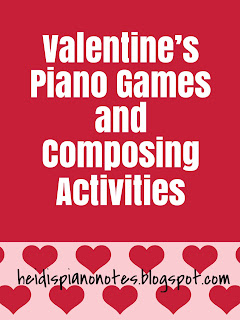Thursday, February 15, 2018
Valentines Composing Piano Group Lessons
VALENTINE COMPOSING- Creating a Melody
Some students are naturally enthralled with composing and can easily dive right in and create beautiful sounding melodies. But some are much more comfortable with a step by step guided approach.
Using Susan Paradis's Valentine Composing Worksheets at group lessons I taught a mini-lesson on composition tips for younger beginners and then had students perform their creations on the spot.
1 - Start with a Scale "Recipe"
When you make cookies or soup you will end up with better results if you limit the ingredients to things that taste good together. In music, a scale is like a list of ingredients. Just as eating cookies with garlic powder doesn't taste very appealing, throwing random music notes together is not likely to sound amazing either. It is easier to create good melody when you start by limiting your "note ingredients" to notes within a scale you are familiar with. For Valentine composing I had them choose a pentascale that could easily fit under beginner's fingers.
2 - Pick a Motif
Using language as a guide for the rhythm can be easier than "pulling a rhythm out of thin air." The repeating rhythms in "Roses are Red" set the stage for a repeating rhythmic motif. I asked the students to write 4 of the letter names from their scale in any order for the first line to create a melodic motif.
3 - "Play" with the Motif
Although repetition can be a good thing, too much of the same thing gets old quick. But a random assortment notes thrown together sometimes doesn't bring the best results either. For the next 2 lines I taught students 2 easy ways to "play with the motif."
Line 2 - Write the letters of your motif from Line 1 backward (ex: CDGE becomes EGDC).
Line 3 - Repeat the first 2 letters from Line 1 and then change the ending.
4 - End at "Home" Although this is not a "never break" rule, your song will sound more finished if you end on the tonic (do) which is the letter name of the scale you chose.
This Any Day Composing activity is a similar activity, perfect for beginning composing practice for any season of the year.
STEAL A HEART - STAFF NOTES
This Steal a Heart Staff Notes game elicited a lot of laughter as students reviewed the note names on the staff, a basic skill necessary when they transcribe their alphabet melodies into real music. My students loved this game so much, I decided to use it at my son's kindergarten Valentine Party. I added some sight words written on post-it notes to several of the cards and the kids got an extra turn if they picked one and could read the word. This extra twist could also be a fun addition if you add music terms or symbols to some of the cards. Kids loved the playfulness of stealing and giving hearts!
HEART CANDY RHYTHMIC DICTATION
It was hard for me to narrow down the perfect game with so many fun options from Compose Create.com on Wendy's Valentine Music Games post, but I chose an adapted version of Candy Heart Rhythm Dictation using Beat Boards from Pianimation.com in sheet protectors with dry erase markers. I wanted to emphasize counting as part of rhythmic dictation so students could more effectively dictate their own melodic creations using correct rhythms, so I added the "counts" below each heart.
1. Begin with Quarter Notes and Rests in 4/4 (1-2-3-4)- Remove the candy on the rests.
2. Quarter and Half Note Rhythms - Remove and eat the candy where the note "holds" and choose the correct note that can fill up the space.
Split each heart in half for more complex eighth note rhythms and subdivide the counting(1&2&3&4&). Students point to the heart halves as they count along to the rhythm to determine which notes are held longer than 1/2 a beat.
COMPOSING INTROS AND OUTROS
We ended with some demos of Bradley Sowash's Easy Introductions. His post about improvising outros has some great ideas to help students complete their compositions with a fabulous finish.
Their take-home challenge was to choose an animal for the theme of their next Animal Menagerie composition project that they will be working on during private lessons this month.
Labels:
composing,
Games,
Group Lessons,
Improvisation
Subscribe to:
Post Comments (Atom)





.png)





No comments:
Post a Comment